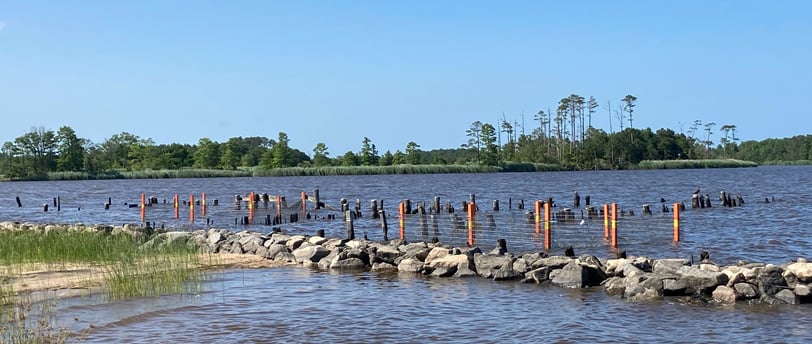The Unsung Heroes of the Lake:
How Submerged Macrophytes Shape Aquatic Ecosystems
3 min read


Lakes are complex ecosystems, teeming with life both visible and microscopic. While much attention is often given to the fish, algae, and microscopic organisms, there's a vital component that often goes unnoticed: submerged macrophytes. These underwater plants play a crucial role in shaping the ecological balance of lakes, influencing everything from water clarity to the intricate food webs that sustain aquatic life.
What are Submerged Macrophytes?
Submerged macrophytes are aquatic plants that live entirely underwater, with their leaves and stems growing below the water's surface. They're found in a variety of freshwater environments, from shallow ponds to large lakes, and come in many shapes and sizes.
Why are Submerged Macrophytes Important?
Submerged macrophytes are more than just pretty plants; they're essential to the health and functioning of lake ecosystems. They affect various biological and biogeochemical interactions, playing a key role in nutrient dynamics, trophic structure, and overall food web balance.
Key Roles of Submerged Macrophytes
Habitat Complexity and Food Webs
Submerged macrophytes create complex habitats that influence interactions between different organisms.
They provide refuge and spawning grounds for fish and invertebrates.
These plants are a food source for some fish and invertebrates, while also supporting a community of epiphytic algae and invertebrates that serve as food for other organisms.
Changes in macrophyte structure can have cascading effects throughout the food web, impacting everything from fish behavior to nutrient cycling.
Water Clarity and Nutrient Dynamics
Submerged macrophytes can help maintain clear water by stabilizing sediments and reducing resuspension, which can otherwise lead to turbidity.
They compete with phytoplankton for nutrients, potentially preventing algal blooms.
Macrophytes also influence nutrient cycling by absorbing nutrients from the water and sediment.
Oxygen Production and Carbon Cycling
Like all plants, submerged macrophytes produce oxygen through photosynthesis, which is vital for aquatic life.
They also play a role in carbon cycling by absorbing carbon dioxide from the water.
The decomposition of macrophytes contributes to the dissolved organic carbon in the lake, which is an important energy source for bacteria and other microorganisms.
The Interplay of Factors
The impact of submerged macrophytes on lake ecosystems is influenced by a variety of factors, including:
Ontogenetic Niche Shifts in Fish: As fish grow, they change their habitat and food preferences, which can affect their interactions with macrophytes and other organisms.
Fish-Macroinvertebrate Interactions: Macrophytes mediate the interactions between fish and macroinvertebrates, influencing predation and competition.
Periphyton Dynamics: Periphyton, the community of algae, bacteria, and other microorganisms that attach to macrophyte surfaces, is an important food source and is influenced by both macrophytes and grazers like snails.
Zooplankton Interactions: Macrophytes provide refuge for zooplankton from fish predation, which can have cascading effects on phytoplankton and water clarity.
Herbivory: Herbivores, including fish, invertebrates, waterfowl, and mammals, can consume macrophytes, affecting their abundance and community structure.
Nutrient Loading: The amount of nutrients entering a lake can influence macrophyte growth, as well as the balance between macrophytes and phytoplankton.
Case Studies: Examples of Macrophyte Influence
The reference text includes various case studies that highlight the diverse ways in which submerged macrophytes shape lake ecosystems:
Fish-Habitat Interactions: Studies show how vegetation structure influences fish foraging and predator avoidance, with habitat shifts affecting competition and predation dynamics.
Trophic Cascades: Research has demonstrated how macrophytes can trigger trophic cascades, where changes at one trophic level (e.g., fish) have indirect effects on other levels (e.g., algae).
Herbivory Impacts: Studies have examined the effects of various herbivores on macrophyte biomass and community composition, revealing the complex interactions between plants and their consumers.
Clear vs. Turbid Water States: Research has explored the role of macrophytes in maintaining clear water conditions in shallow lakes and the factors that can cause a shift to turbid, algae-dominated states.
Nutrient Dynamics: Investigations have shown how macrophytes influence nutrient cycling, sedimentation, and resuspension, affecting water quality and phytoplankton growth.
The Big Picture: Macrophytes and Lake Management
Understanding the structuring role of submerged macrophytes is crucial for effective lake management. By recognizing the importance of these underwater plants, we can develop strategies to protect and restore them, leading to healthier, more resilient lake ecosystems. Some management considerations include:
Nutrient Control: Reducing nutrient pollution to prevent excessive algal growth that can outcompete macrophytes.
Habitat Protection: Preserving macrophyte beds from physical disturbance and destructive practices.
Fisheries Management: Maintaining balanced fish populations to avoid excessive predation on zooplankton, which can help control algae.
Herbivore Management: Considering the role of herbivores in macrophyte dynamics and managing their populations if necessary.
Restoration Efforts: Implementing strategies to restore macrophyte communities in degraded lakes, such as transplanting or creating suitable growing conditions.
Conclusion
Submerged macrophytes are essential players in the intricate web of life within lake ecosystems. Their influence on habitat structure, food web dynamics, water clarity, nutrient cycling, and other key processes cannot be overstated. By delving deeper into the world of these underwater plants, we gain valuable insights into how to protect and preserve the health of our lakes for generations to come.
#SubmergedMacrophytes
#LakeEcology
#AquaticEcosystems
#FreshwaterBiology
#TrophicInteractions
